sensor TOYOTA PRIUS PRIME 2021 (in English) Owner's Guide
[x] Cancel search | Manufacturer: TOYOTA, Model Year: 2021, Model line: PRIUS PRIME, Model: TOYOTA PRIUS PRIME 2021Pages: 808, PDF Size: 74.05 MB
Page 436 of 808

436
PRIUS PRIME_OM_OM47D71U_(U)
5-5. Using the driving support systems
WARNING
■Handling the radar sensor
●Keep the sensor and its surrounding area on the bumper clean at all times.
●Do not subject a sensor or its surrounding area on the rear bumper to a
strong impact.
If a sensor is moved even slightly off position, the system may malfunction
and vehicles may not be detected correctly.
In the following situations, have your vehicle inspected by your Toyota
dealer.
• A sensor or its surrounding area is subject to a strong impact.
• If the surrounding area of a sensor is scratched or dented, or part of
them has become disconnected.
●Do not disassemble the sensor.
●Do not attach accessories or stickers to the sensor or surrounding area on
the bumper.
●Do not modify the sensor or surrounding area on the bumper.
●Do not paint the rear bumper any color other than an official Toyota color.
One Blind Spot Monitor sensor is
installed inside the left and right side of
the vehicle rear bumper respectively.
Observe the following to ensure the Blind
Spot Monitor can function correctly.
Page 437 of 808
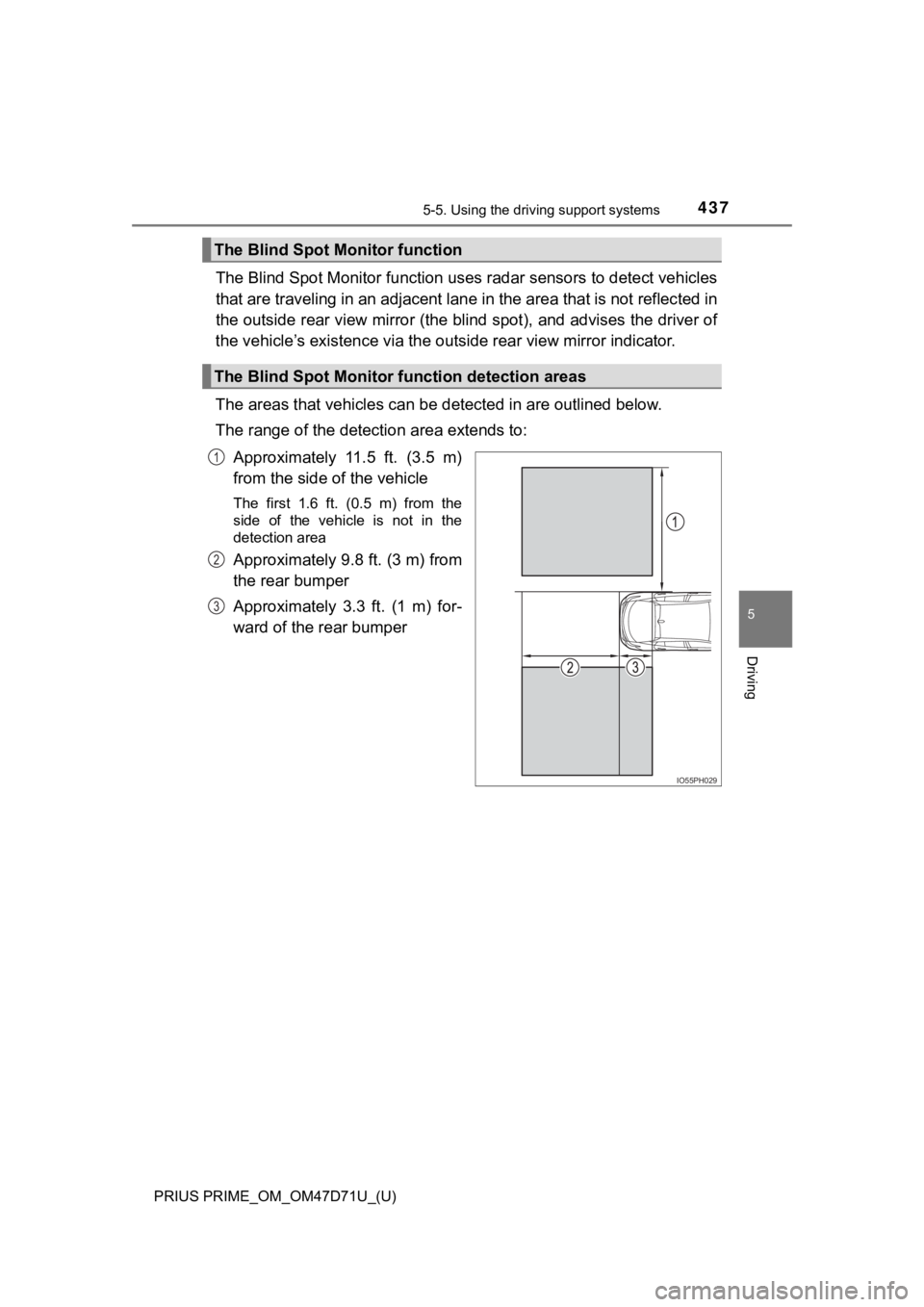
PRIUS PRIME_OM_OM47D71U_(U)
4375-5. Using the driving support systems
5
Driving
The Blind Spot Monitor function uses radar sensors to detect vehicles
that are traveling in an adjacent lane in the area that is not reflected in
the outside rear view mirror (the blind spot), and advises the driver of
the vehicle’s existence via the outside rear view mirror indicator.
The areas that vehicles can be detected in are outlined below.
The range of the detection area extends to:
Approximately 11.5 ft. (3.5 m)
from the side of the vehicle
The first 1.6 ft. (0.5 m) from the
side of the vehicle is not in the
detection area
Approximately 9.8 ft. (3 m) from
the rear bumper
Approximately 3.3 ft. (1 m) for-
ward of the rear bumper
The Blind Spot Monitor function
The Blind Spot Monitor function detection areas
IO55PH029
1
2
3
Page 439 of 808
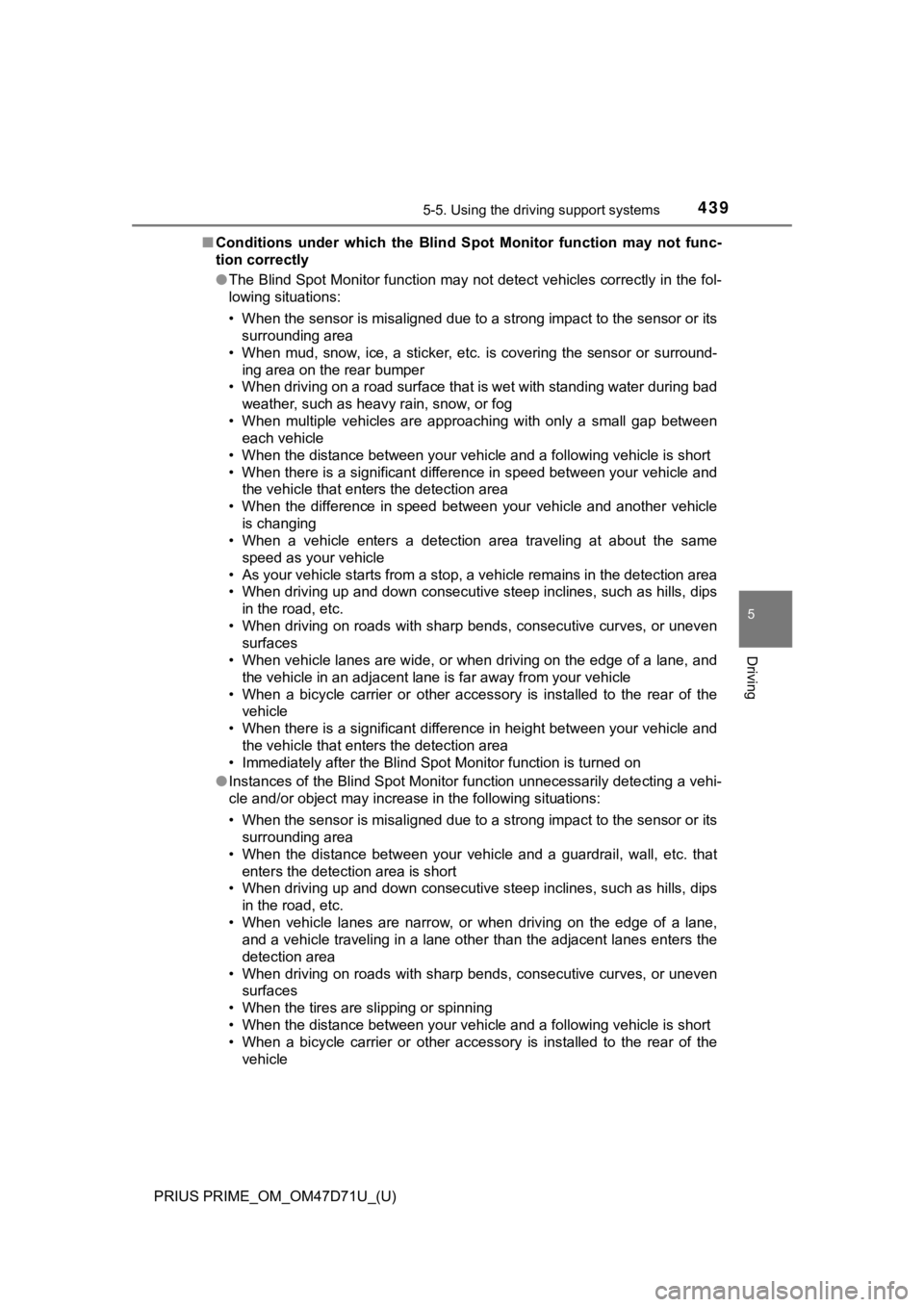
PRIUS PRIME_OM_OM47D71U_(U)
4395-5. Using the driving support systems
5
Driving
■Conditions under which the Blind Spot Monitor function may not func-
tion correctly
●The Blind Spot Monitor function may not detect vehicles correctly in the fol-
lowing situations:
• When the sensor is misaligned due to a strong impact to the sensor or its
surrounding area
• When mud, snow, ice, a sticker, etc. is covering the sensor or surround-
ing area on the rear bumper
• When driving on a road surface that is wet with standing water during bad
weather, such as heavy rain, snow, or fog
• When multiple vehicles are approaching with only a small gap between
each vehicle
• When the distance between your vehicle and a following vehicle is short
• When there is a significant difference in speed between your vehicle and
the vehicle that enters the detection area
• When the difference in speed between your vehicle and another vehicle
is changing
• When a vehicle enters a detection area traveling at about the same
speed as your vehicle
• As your vehicle starts from a stop, a vehicle remains in the detection area
• When driving up and down consecutive steep inclines, such as hills, dips
in the road, etc.
• When driving on roads with sharp bends, consecutive curves, or uneven
surfaces
• When vehicle lanes are wide, or when driving on the edge of a lane, and
the vehicle in an adjacent lane is far away from your vehicle
• When a bicycle carrier or other accessory is installed to the rear of the
vehicle
• When there is a significant difference in height between your vehicle and
the vehicle that enters the detection area
• Immediately after the Blind Spot Monitor function is turned on
●Instances of the Blind Spot Monitor function unnecessarily detecting a vehi-
cle and/or object may increase in the following situations:
• When the sensor is misaligned due to a strong impact to the sensor or its
surrounding area
• When the distance between your vehicle and a guardrail, wall, etc. that
enters the detection area is short
• When driving up and down consecutive steep inclines, such as hills, dips
in the road, etc.
• When vehicle lanes are narrow, or when driving on the edge of a lane,
and a vehicle traveling in a lane other than the adjacent lanes enters the
detection area
• When driving on roads with sharp bends, consecutive curves, or uneven
surfaces
• When the tires are slipping or spinning
• When the distance between your vehicle and a following vehicle is short
• When a bicycle carrier or other accessory is installed to the rear of the
vehicle
Page 440 of 808
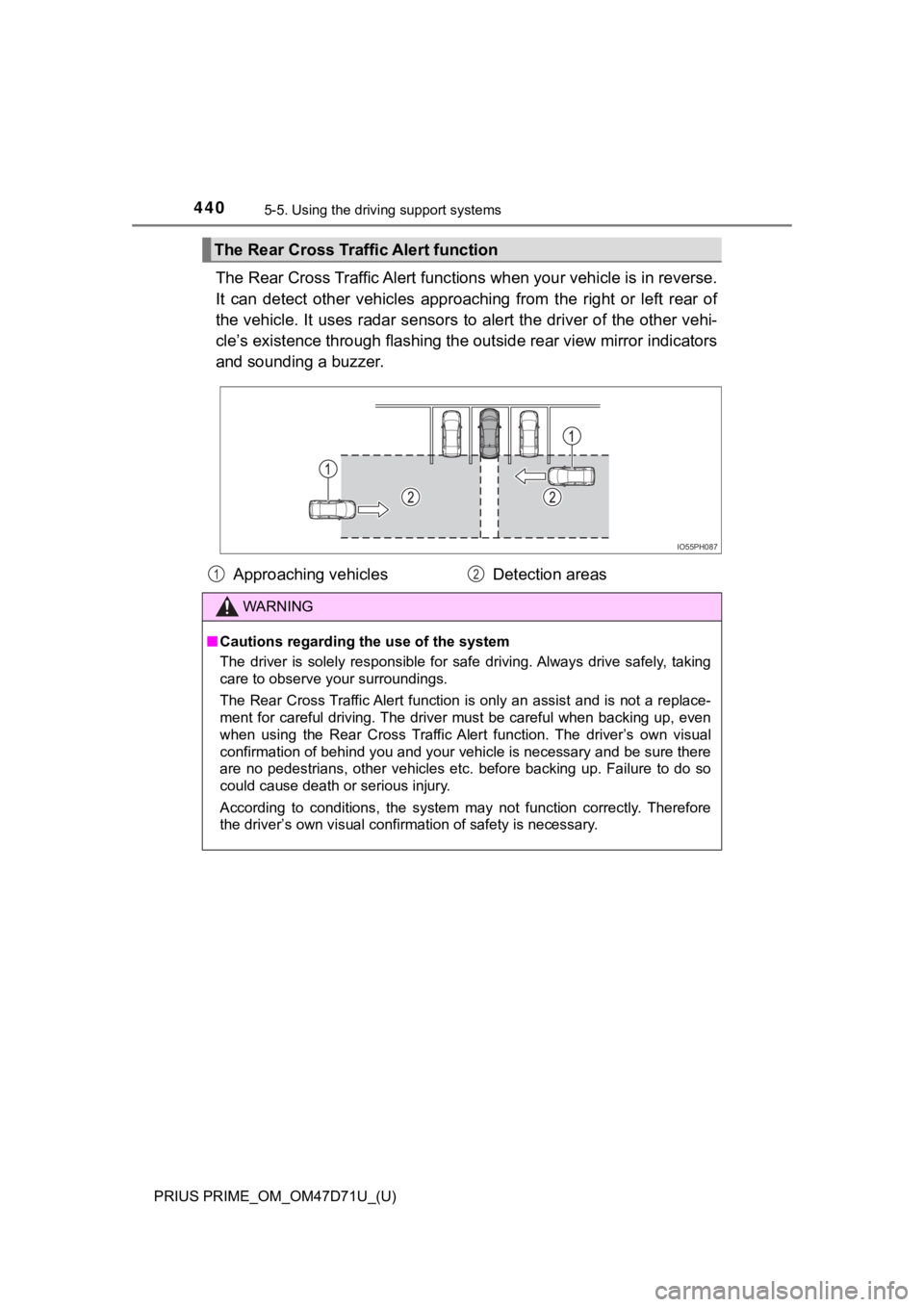
440
PRIUS PRIME_OM_OM47D71U_(U)
5-5. Using the driving support systems
The Rear Cross Traffic Alert functions when your vehicle is in reverse.
It can detect other vehicles approaching from the right or left rear of
the vehicle. It uses radar sensors to alert the driver of the other vehi-
cle’s existence through flashing the outside rear view mirror indicators
and sounding a buzzer.
The Rear Cross Traffic Alert function
IO55PH087
Approaching vehicles Detection areas
WARNING
■Cautions regarding the use of the system
The driver is solely responsible for safe driving. Always drive safely, taking
care to observe your surroundings.
The Rear Cross Traffic Alert function is only an assist and is not a replace-
ment for careful driving. The driver must be careful when backing up, even
when using the Rear Cross Traffic Alert function. The driver’s own visual
confirmation of behind you and your vehicle is necessary and be sure there
are no pedestrians, other vehicles etc. before backing up. Failure to do so
could cause death or serious injury.
According to conditions, the system may not function correctly. Therefore
the driver’s own visual confirmation of safety is necessary.
12
Page 442 of 808
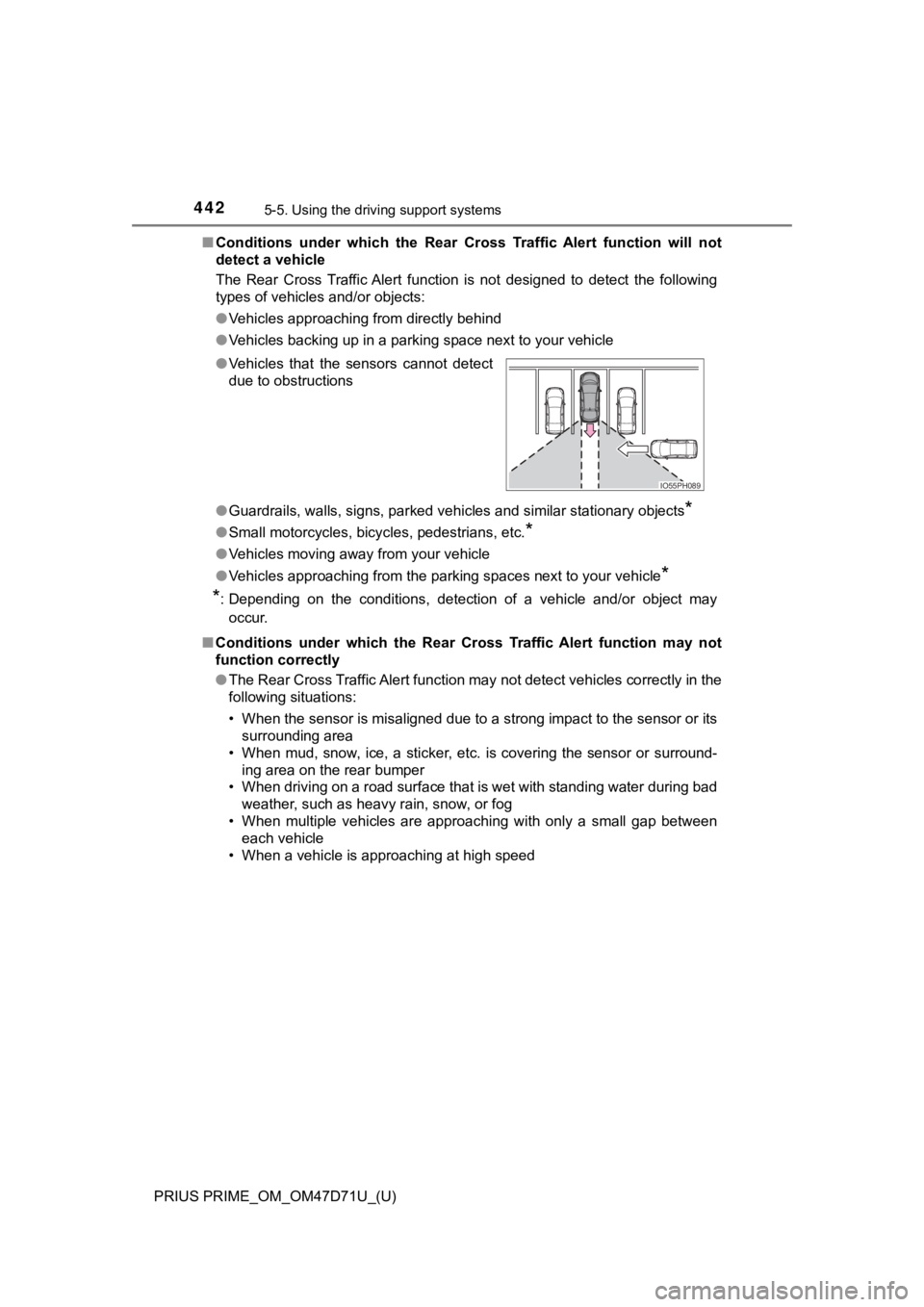
442
PRIUS PRIME_OM_OM47D71U_(U)
5-5. Using the driving support systems
■Conditions under which the Rear Cross Traffic Alert function will not
detect a vehicle
The Rear Cross Traffic Alert function is not designed to detect the following
types of vehicles and/or objects:
●Vehicles approaching from directly behind
●Vehicles backing up in a parking space next to your vehicle
●<002a005800440055004700550044004c004f0056000f0003005a0044004f004f0056000f00030056004c004a00510056000f0003005300440055004e00480047000300590048004b004c0046004f00480056000300440051004700030056004c0050004c00
4f0044005500030056005700440057004c0052005100440055[y objects
*
●Small motorcycles, bicycles, pedestrians, etc.*
●Vehicles moving away from your vehicle
●Vehicles approaching from the parking spaces next to your vehicle
*
*
: Depending on the conditions, detection of a vehicle and/or object may
occur.
■Conditions under which the Rear Cross Traffic Alert function may not
function correctly
●The Rear Cross Traffic Alert function may not detect vehicles correctly in the
following situations:
• When the sensor is misaligned due to a strong impact to the sensor or its
surrounding area
• When mud, snow, ice, a sticker, etc. is covering the sensor or surround-
ing area on the rear bumper
• When driving on a road surface that is wet with standing water during bad
weather, such as heavy rain, snow, or fog
• When multiple vehicles are approaching with only a small gap between
each vehicle
• When a vehicle is approaching at high speed ●Vehicles that the sensors cannot detect
due to obstructions
IO55PH089
Page 443 of 808
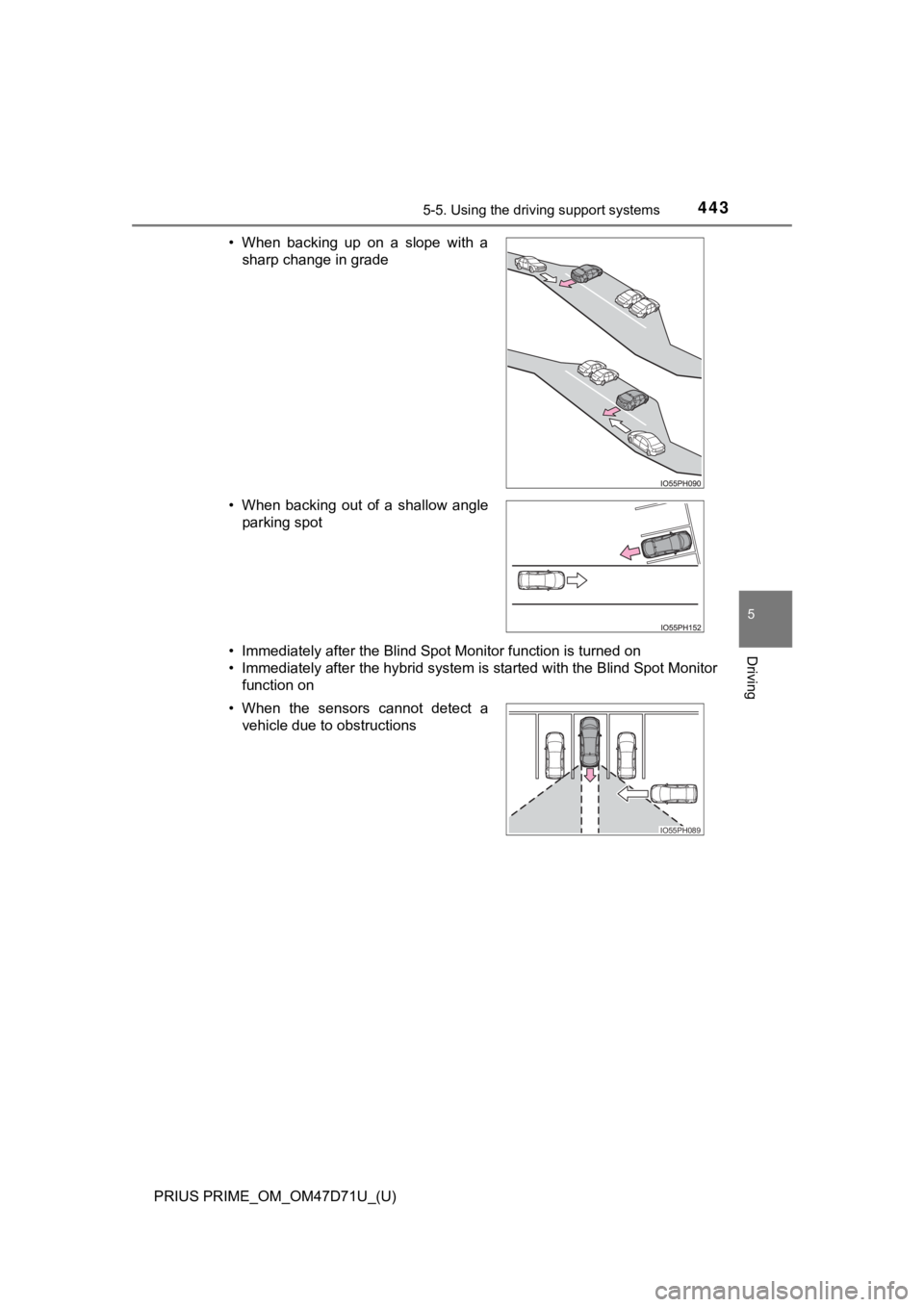
PRIUS PRIME_OM_OM47D71U_(U)
4435-5. Using the driving support systems
5
Driving• Immediately after the Blind Spot Monitor function is turned on
• Immediately after the hybrid system is started with the Blind Spot Monitor
function on • When backing up on a slope with a
sharp change in grade
• When backing out of a shallow angle
parking spot
• When the sensors cannot detect a
vehicle due to obstructions
IO55PH089
Page 445 of 808
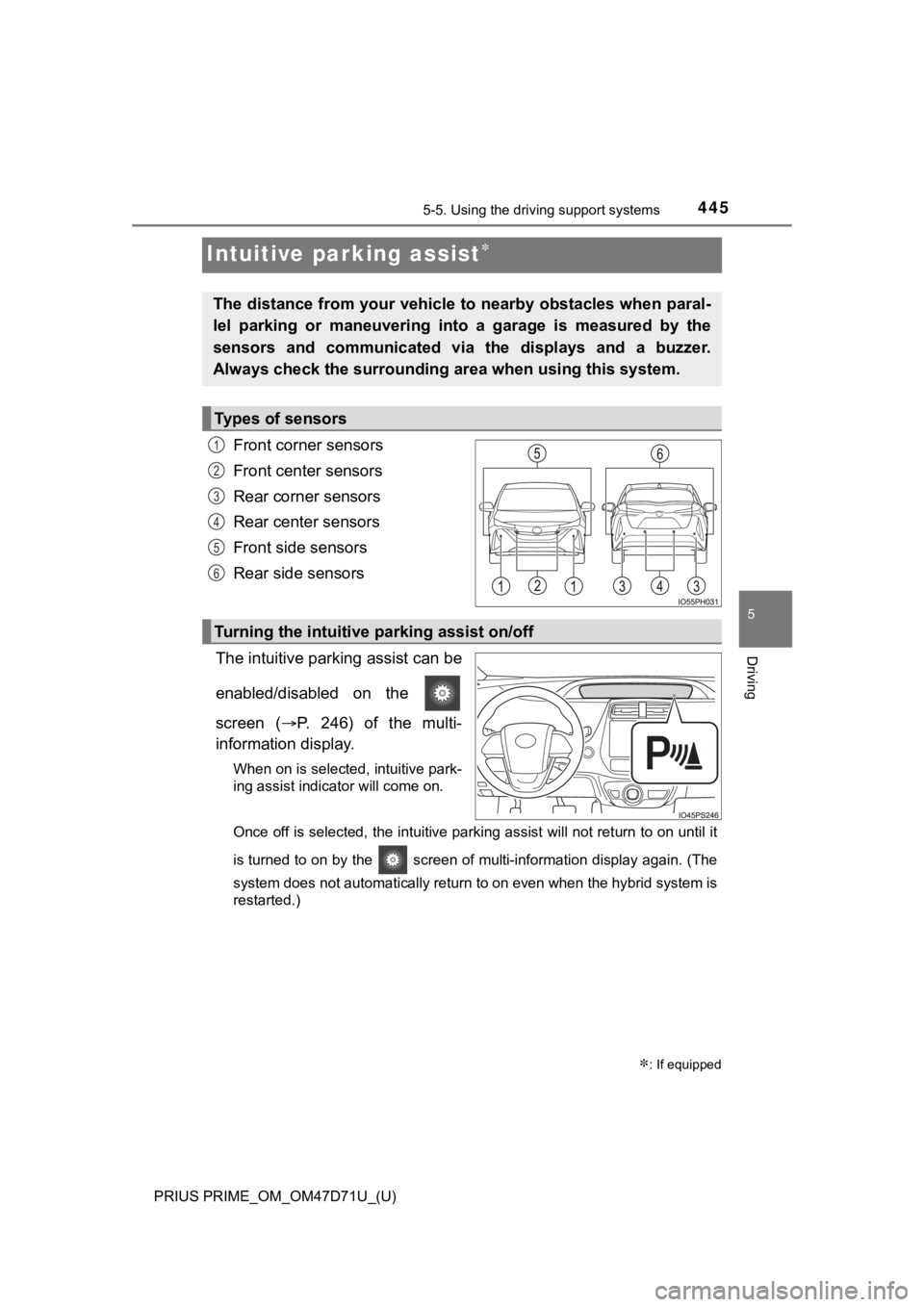
445
PRIUS PRIME_OM_OM47D71U_(U)
5-5. Using the driving support systems
5
Driving
Intuitive parking assist
Front corner sensors
Front center sensors
Rear corner sensors
Rear center sensors
Front side sensors
Rear side sensors
The intuitive parking assist can be
enabled/disabled on the
screen (P. 246) of the multi-
information display.
When on is selected, intuitive park-
ing assist indicator will come on.
Once off is selected, the intuitive parking assist will not return to on until it
is turned to on by the screen of multi-information display again. (The
system does not automatically return to on even when the hybrid system is
restarted.)
: If equipped
The distance from your vehicle to nearby obstacles when paral-
lel parking or maneuvering into a garage is measured by the
sensors and communicated via the displays and a buzzer.
Always check the surrounding area when using this system.
Types of sensors
1
2
3
4
5
6
Turning the intuitive parking assist on/off
Page 446 of 808
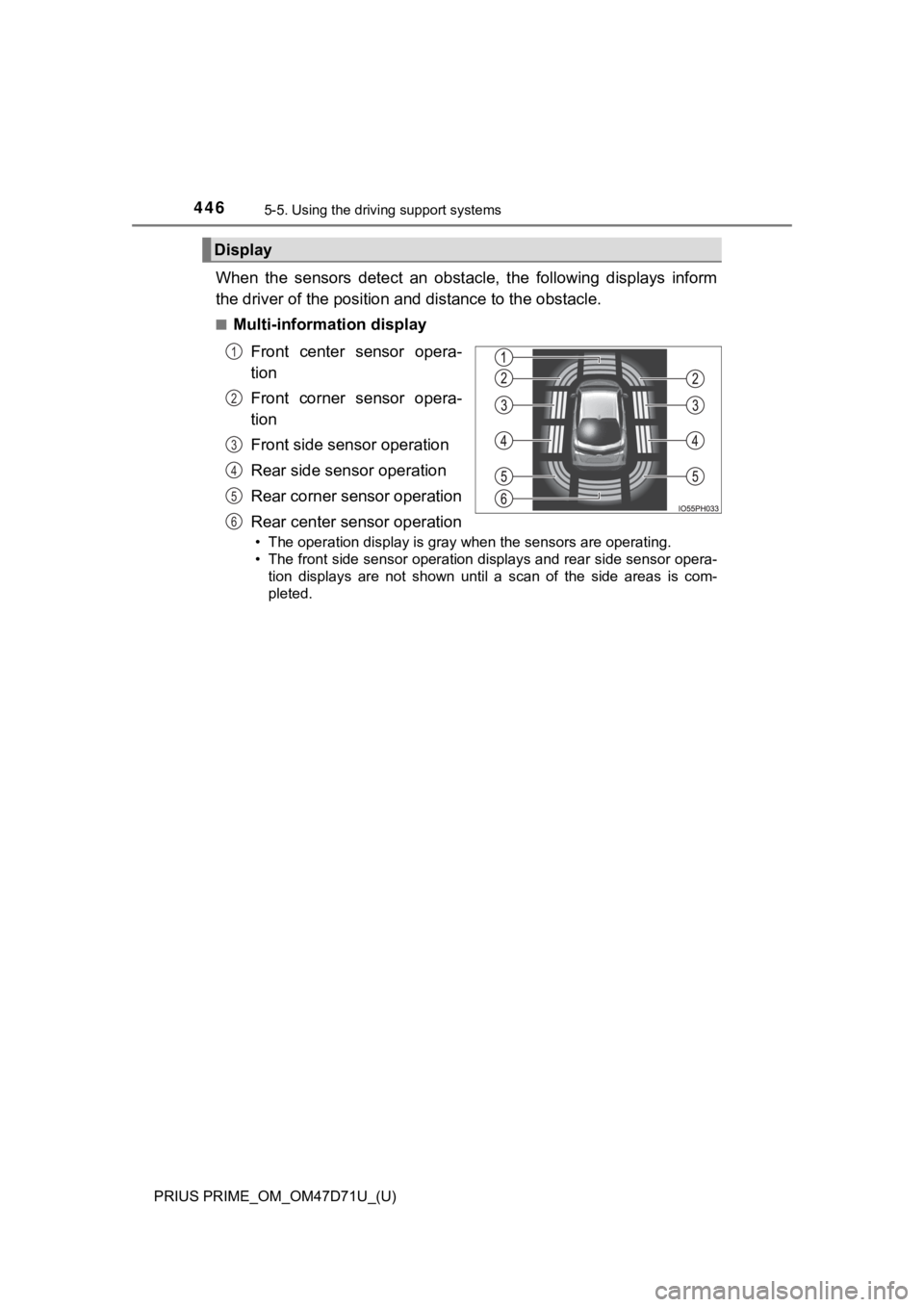
446
PRIUS PRIME_OM_OM47D71U_(U)
5-5. Using the driving support systems
When the sensors detect an obstacle, the following displays inform
the driver of the position and distance to the obstacle.
■Multi-information display
Front center sensor opera-
tion
Front corner sensor opera-
tion
Front side sensor operation
Rear side sensor operation
Rear corner sensor operation
Rear center sensor operation
• The operation display is gray when the sensors are operating.
• The front side sensor operation displays and rear side sensor opera-
tion displays are not shown until a scan of the side areas is com-
pleted.
Display
1
2
3
4
5
6
Page 447 of 808

PRIUS PRIME_OM_OM47D71U_(U)
4475-5. Using the driving support systems
5
Driving
■Distance display
Sensors that detect an obstacle will illuminate continuously or blink.
*: The images may differ from those shown in the illustrations depending on
the detection status. (P. 446)
Sensor detection display, obstacle distance
Display*
Approximate distance to obstacle
Front corner, front
center and front side
sensorsRear corner, rear
center and rear side
sensors
(continuous)
3.3 ft. (100 cm) to
2.0 ft (60 cm)4.9 ft. (150 cm) to
2.0 ft. (60 cm)
(continuous)
2.0 ft. (60 cm) to
1.5 ft (45 cm)
2.0 ft. (60 cm) to
1.5 ft. (45 cm)
3.3 ft. (100 cm) to
2.3 ft. (70 cm)3.3 ft. (100 cm) to
2.3 ft. (70 cm)
2.0 ft. (60 cm) to
1.5 ft (45 cm)
2.0 ft. (60 cm) to
1.5 ft. (45 cm)
(continuous)
1.5 ft. (45 cm) to
1.2 ft. (35 cm)
1.5 ft. (45 cm) to
1.2 ft. (35 cm)
2.3 ft. (70 cm) to
1.0 ft. (30 cm)2.3 ft. (70 cm) to
1.0 ft. (30 cm)
1.5 ft. (45 cm) to
1.2 ft. (35 cm)
1.5 ft. (45 cm) to
1.2 ft. (35 cm)
(blinking)
Less than
1.2 ft. (35 cm)
Less than
1.2 ft. (35 cm)
Less than
1.0 ft. (30 cm)Less than
1.0 ft. (30 cm)
Less than
1.2 ft. (35 cm)
Less than
1.2 ft. (35 cm)
Far
Near
16
1
2
3
4
5
6
1
2
3
4
5
6
1
2
3
4
5
6
Front center sensors
Front corner sensors
Front side sensorsRear side sensors
Rear corner sensors
Rear center sensors1
2
3
4
5
6
Page 448 of 808

448
PRIUS PRIME_OM_OM47D71U_(U)
5-5. Using the driving support systems
When an obstacle is detected, the buzzer sounds.
●As the obstacle is approached, the buzzer sounds more rapidly.
When the obstacle is extremely close, the buzzer switches from
sounding intermittently (short beeps) to continuously (a long beep).
• Distance to obstacle detected by front corner sensor is approxi-
mately 1.2 ft. (35 cm) or less
• Distance to obstacle detected by front side sensor or rear side
sensor is approximately 1.0 ft. (30 cm) or less
• Distance to obstacle detected by front sensor is approximately
1.2 ft. (35 cm) or less
• Distance to obstacle detected by rear corner sensor is approxi-
mately 1.2 ft. (35 cm) or less
• Distance to obstacle detected by back sensor is approximately
1.2 ft. (35 cm) or less
●When an obstacle is detected by multiple sensors simultaneously,
the buzzer sounds according to the distance to the closest obsta-
cle.
●When obstacles are simultaneously detected to the front and rear
of the vehicle, separate buzzers sound patterns according to the
distance to each obstacle.
The volume and timing of the buzzer can be changed. (P. 753)
Buzzer